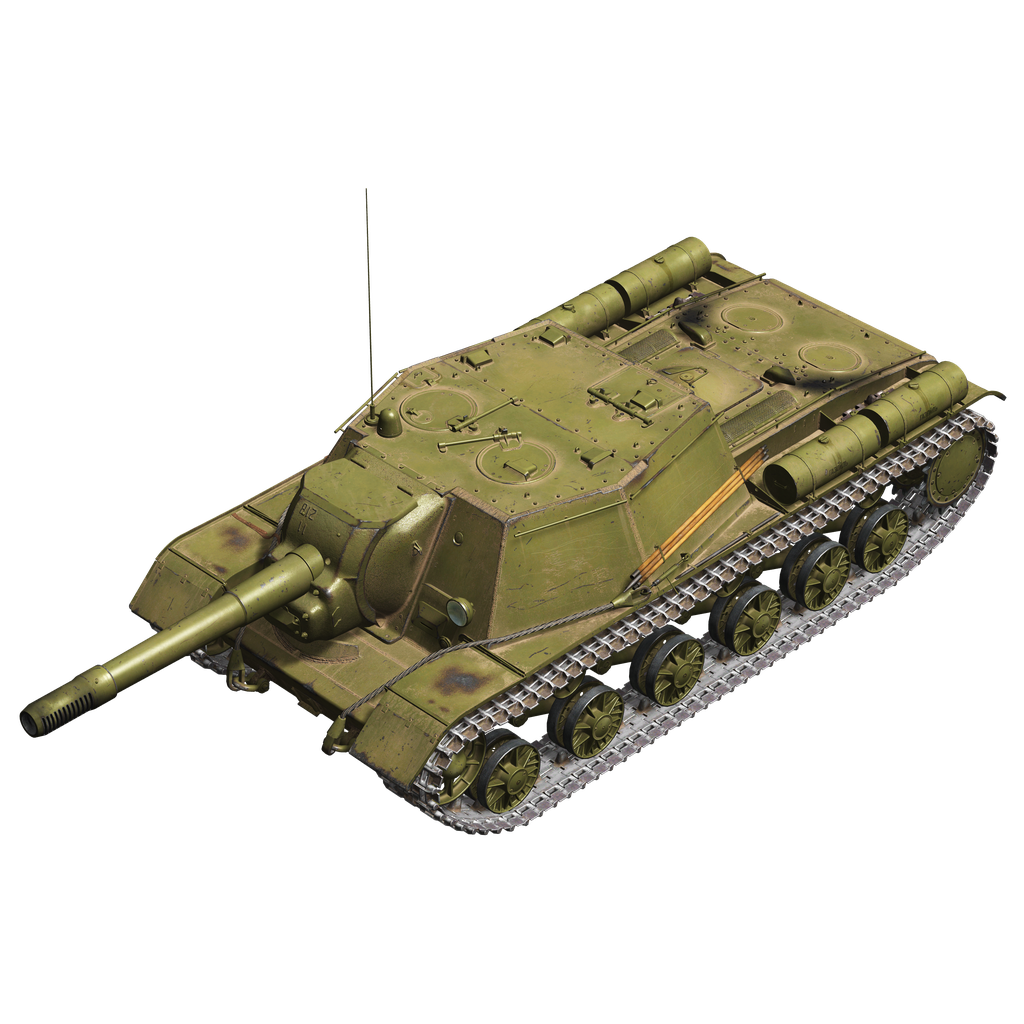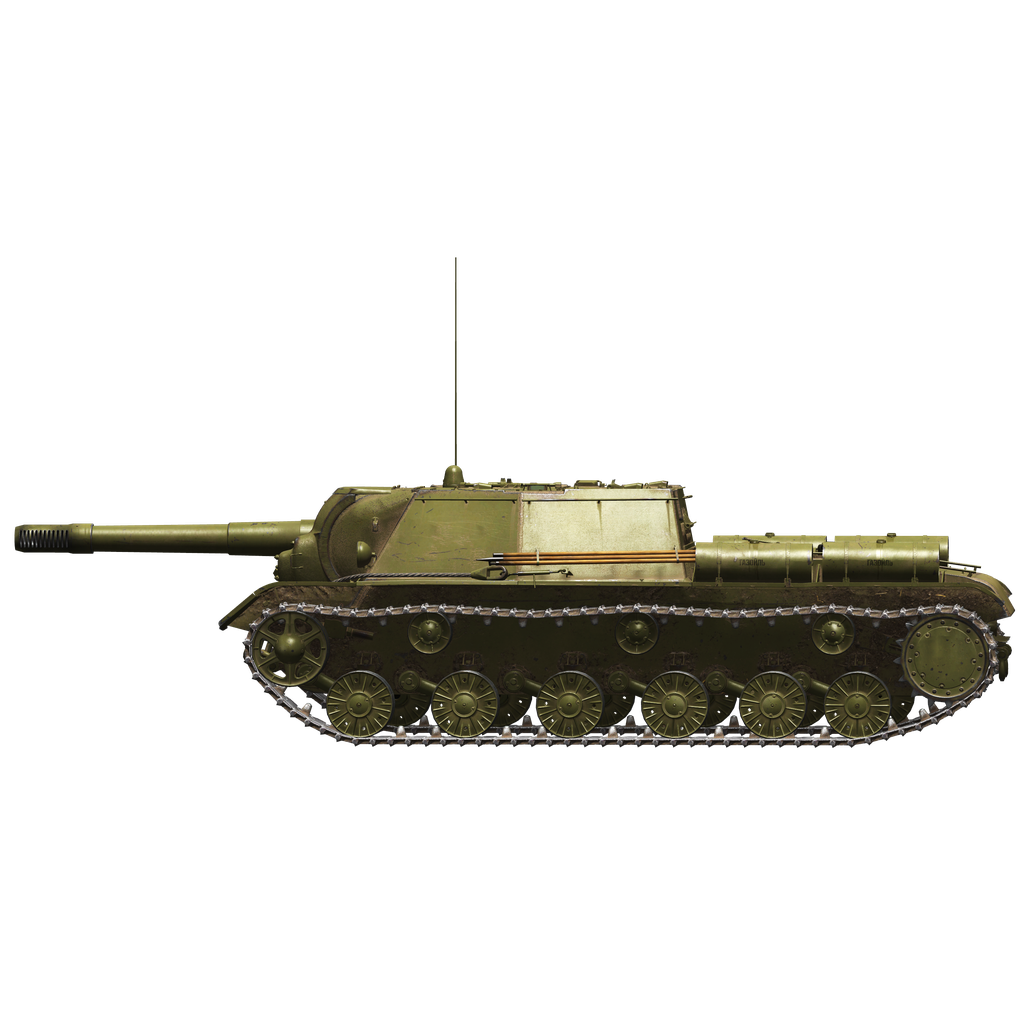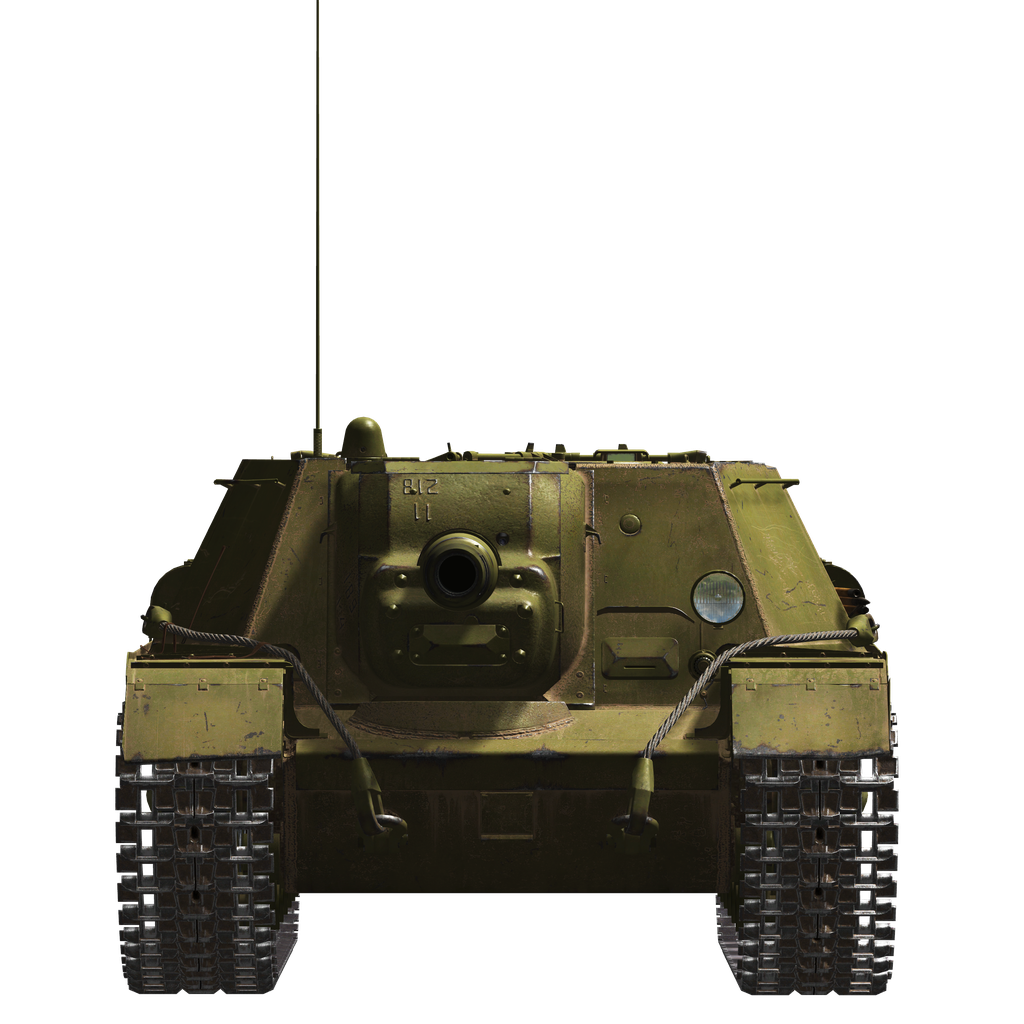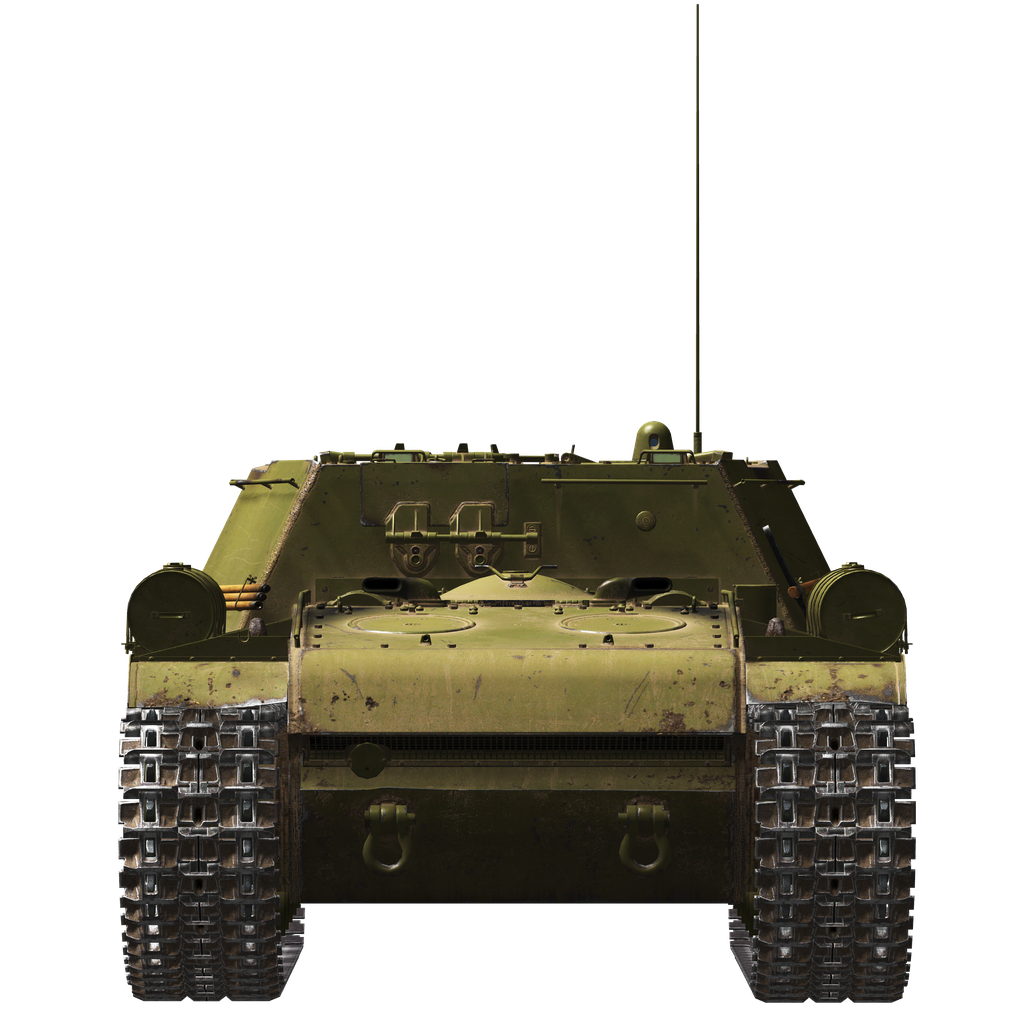The combat experience of the initial period of the Great Patriotic War proved the necessity of accompanying tanks in battle with self-propelled artillery, and in October 1942 the State Defense Committee decided to begin work on the creation of not only light and medium, but also heavy self-propelled artillery (SPG). This self-propelled artillery was to be armed with a 152 mm ML-20 mod. 1937 howitzer and used in offensive operations to break through the enemy's fortified defenses. The Chelyabinsk Kirov Plant (ChKZ) was entrusted with the creation of the machine. The KV-14 belonged to the type of fully armored self-propelled units with a frontally-armored cabin and was created on the basis of the KV-1S tank.
The SU-152 (KV-14) was the hull of the KV-1S tank, whose control and fighting compartments were combined in a welded casemate. The crew consisted of five soldiers: the driver was located in the front left control compartment, behind him the gunner, behind the gunner the loader, to the right of the gun in front the commander of the vehicle and behind him the turret commander. For observation of the battlefield a PTK-4 periscope was used, which provided a panoramic view, and five prismatic mirrors were installed on the roof of the superstructure and on the covers of the left and rear hatches. There was an escape hatch in the right hatch cover.
In the engine compartment, a V-2K diesel engine was installed along the longitudinal axis of the fuselage, along with engine and transmission components and fuel tanks.
The armament of these self-propelled guns consisted of a 152 mm howitzer-gun, model 1937, ML-20S. The direct firing range of the gun was 3800 m and the maximum indirect firing range was 6.2 km. The following rounds were used for firing: OF-540 high-explosive long-range steel cannon shell (43.56 kg, 655 m/s), G-530 concrete-piercing howitzer shell, OF-530 high-explosive long-range steel howitzer shell, 0-530A cast-steel long-range fragmentation howitzer shell, B-540 armor-piercing tracer shell (48.78 kg) and high-explosive naval semi-armor-piercing shell with KTMF fuze. Loading was separate: charges for the new and old guns were used, and special charges were used for firing armor-piercing tracer shells (with an initial velocity of 600 m/s) and high-explosive naval semi-armor-piercing shells (with an initial velocity of 573 m/s).
A total of 670 SU-152s were produced. The self-propelled guns entered service with the heavy self-propelled regiments of the Stavka. SU-152s entered combat for the first time at the Kursk Bulge and despite the small number of available vehicles the effect of their use turned out to be very significant. It was then that the self-propelled gun received the respectful nickname "St. John's Wort": heavy armor-piercing shells penetrated the armor of any Wehrmacht tank at a distance of up to 1500 m. Even if the shell did not penetrate the armor of an enemy vehicle, it disabled it due to failure of components and mechanisms caused by concussion and injured the crew with fragments from internal armor splinters. Shooting at enemy equipment with high-explosive and concrete-piercing shells also gave good results (after all, the G-530 concrete-piercing shell penetrated reinforced concrete walls about 1 m thick).
SU-152s were used at the front until the summer of 1944, mainly as heavy antitank guns — then they were replaced by the new ISU-152 and ISU-122 heavy self-propelled guns.
Used sources:
1. M. Baryatinsky “Heavy self-propelled guns of the Red Army”, magazine “Armor Collection” No. 02 2006.
2. M. Svirin “Stalin’s self-propelled guns. History of Soviet self-propelled guns 1919-1945" 2008
3. G.L. Kholyavsky “Complete encyclopedia of tanks of the world 1915 - 2000” 1999
SU-152 heavy assault gun has been produced at the Kirov tank factory in Chelyabinsk (ChKZ) from February 1943 till January 1944. 670 units were produced in total.
The assault gun was built on KV-1s tank chassis, so its engine compartment remained the same while the fighting and driving compartments were new. It had only one weapon installed - 152mm ML-20 all-purpose gun. The crew compartment was wider than the hull but was armored good enough. Its array of aiming instruments included the telescopic gunsight for direct fire, gunner's panoramic gunsight with an independent line of sight and PTK-5 panoramic visor for the commander.
During the Kursk battle, SU-152 was the only Soviet armoured vehicle capable of engaging the newest German heavy tanks at 1.5-2 km distances.
Unladen weight: 45500 kg.
Length: 8.7 m.
Width: 3.3 m.
Height: 2.3 m.
Clearance: 440 mm.
Engine: В-2К, diesel.
Maximum power: 600 HP at 2000 RPM.
Maximum RPM: 2150 RPM.
4 speed gearbox with 2 stage demultiplier.
Maximum road speed:
1-st low: 4.5 kph.
2-st low: 6.6 kph.
3-st low: 9.3 kph.
4-st low: 12.9 kph.
1-st high: 16.0 kph.
2-st high: 23.1 kph.
3-st high: 33.0 kph.
4-st high: 45.4 kph.
Reverse low: 5.0 kph.
Reverse high: 17.9 kph.
Maximum offroad speed: 24 kph.
Endurance range: 200 km.
Fluids:
Internal fuel tanks capacity: 545 l.
External fuel tanks capacity: 280 l.
Engine oil system capacity: 100 l.
Summer engine coolant: 150 l. of water
Winter engine coolant: 150 l. of 67% ethylene-glycol
Maximum oil consumption: 11 l/h.
Hull armour:
Gun mantlet: 60-70 mm cast armour.
Upper front: 75 mm rolled armour.
Middle front: 50 mm rolled armour.
Lower front: 60 mm rolled armour.
Sides: 60 mm rolled armour.
Rear: 60 mm rolled armour.
Frontal roof: 20 mm rolled armour.
Rear roof: 30 mm rolled armour.
Bottom: 30 mm rolled armour.
Bottom above tracks: 25 mm rolled armour.
Main gun: rifled, 152 mm ML-20S, separate loading.
Barrel length: 22.8.
Elevation: +18°..-3°.
Azimuth: +7°..-7°.
Ammo: up to 20 rounds.
Usable rate of fire: 2.4 rounds per minute.
Turret drive: mechanical.
Gun ammunition:
OF-540 high explosive (HE): 43.56 kg, 655 m/s, 6.25 kg explosives.
Gunsight settings
(Distance - mils scale):
00000m - 000
00200m - 002 04200m - 059 08200m - 154
00400m - 004 04400m - 063 08400m - 160
00600m - 007 04600m - 067 08600m - 167
00800m - 009 04800m - 071 08800m - 173
01000m - 012 05000m - 075 09000m - 180
01200m - 014 05200m - 079 09200m - 187
01400m - 017 05400m - 083 09400m - 195
01600m - 020 05600m - 087 09600m - 203
01800m - 022 05800m - 092 09800m - 210
02000m - 025 06000m - 096 10000m - 218
02200m - 027 06200m - 101 10200m - 226
02400m - 030 06400m - 105 10400m - 234
02600m - 033 06600m - 110 10600m - 242
02800m - 036 06800m - 115 10800m - 251
03000m - 039 07000m - 120 11000m - 259
03200m - 042 07200m - 125 11200m - 267
03400m - 045 07400m - 131 11400m - 276
03600m - 048 07600m - 137 11600m - 285
03800m - 052 07800m - 142 11800m - 294
04000m - 055 08000m - 148 12000m - 303
BR-540 armour piercing high explosive (APHE): 48.78 kg, 600 m/s, 1.2 kg explosives.
Gunsight settings
(Distance - mils scale):
0000m - 00
0100m - 02 1100m - 16
0200m - 03 1200m - 17
0300m - 04 1300m - 19
0400m - 06 1400m - 20
0500m - 07 1500m - 22
0600m - 09 1600m - 23
0700m - 10 1700m - 24
0800m - 11 1800m - 26
0900m - 13 1900m - 28
1000m - 14 2000m - 29
Gunsights:
ST-10 gunner scope-sight, field of view 18°.
PG gunner panoramic periscopic sight, field of view 10.5°, allows indirect fire.
PTK commander panoramic periscopic sight, field of view 26°.
Radio equipment:
VHF 9-RM transceiver.
3 intercom terminals.





